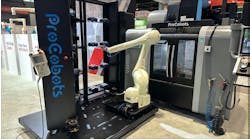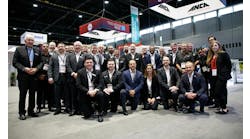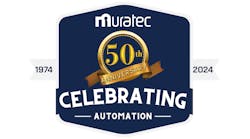Paul Bocchi is general manager at ANCA Motion.
What are three key things that a machine builder, system integrator or manufacturer should know about your organization?
Paul Bocchi, general manager, ANCA Motion: With headquarters in Australia, we have been involved in motion control for more than 45 years. Our CNC and motion control technology has evolved over this time by proving its performance in demanding applications such as five-axis precision grinding and high-speed laser cutting.
Our highly skilled global team is passionate about motion control. To achieve high speed and sub-micron precision for demanding applications requires a multi-disciplinary team that understands their field to the smallest detail.
We design, manufacture and provide global support for all components in our solution from CNC IPC, software, servo drives, HMI, I/O and motors. Our unique LinX tubular linear motors are used in CNC and general automation applications where flexible positioning and machine dynamics is required.
What new technologies are driving product development and why?
Paul Bocchi, general manager, ANCA Motion: Technology is moving at a rapid rate in many areas related to our product development ranging from the details of electronic design to macro trends such as IoT and big data. Our hardware products are currently evolving, utilizing ongoing advancements in areas such as silicon carbide power semiconductors and the increasing capabilities in microprocessors for servo control. This allows us to design more compact and efficient servo drives with additional computational capacities to add advanced control capabilities and diagnostics. In CNC applications, such as laser cutting, advances in fiber laser technology has resulted in laser power significantly increasing in a short period of time. This creates the exciting challenge to work with our customers to fully utilize increasing laser power by pushing machines and our CNC system development to produce the most productive laser cutting machines ever seen on the market. Ongoing trends and capabilities around IIoT and the ability to collect and communicate large amounts of data are driving development in core functionality to allow collection and communication of internally generated data, as well as that of integrated third-party sensors and devices. The growing acceptance of having machines connected to the Internet also means a stronger focus on security, particularly on our IPC/CNC solutions.
How does the Industrial Internet of Things figure into business strategy?
Paul Bocchi, general manager, ANCA Motion: As a motion-control provider specializing in CNC control, we primarily act as an IIoT enabler. At a core level, we provide functionality to connect to third-party devices and provide means to collect and communicate information relating to many detailed parts of the system. Information can be collected on motor currents, temperatures, axis positions, velocities and vibration. This information can then be utilized for a multitude of purposes including advanced diagnostics, prognostics for preventive maintenance purposes, process analytics and optimization, MES integration and development of digital twins. As our Windows-based IPC/CNC controller can act as an IoT gateway, security is an increasingly important consideration as part of our solution offering. As IIoT is an enabling set of capabilities and technologies, the ongoing challenge for a motion control company such as ANCA Motion is in finding new and innovative ways to utilize today’s data collection and analysis capabilities to solve real-world problems. As our customers are often the application domain experts, this also requires working closely with them to understand their challenges, as well as those of their customers. All these elements mean that we are gradually shifting more focus toward software and information technology elements of our solutions as they increasingly lead the road our roadmaps will follow.
How will machine automation and controls alter the way companies staff their operations in the future?
Paul Bocchi, general manager, ANCA Motion: Over the years, we have seen ongoing increases in the level of automation on customers’ machines. Depending on the application, machines equipped with automatic loading stations are now commonplace for long-batch lights-out production. Increasingly, we see capabilities develop in manufacturing around unmanned small-batch automation integrated with ERP systems that allow jobs to be scheduled and raw material to be delivered where required for machining. Improved automation across the manufacturing value stream means that complex operations can occur fully unmanned including off-machine measurement and compensation feedback all integrated with manufacturing execution systems.
Manufacturing cells are increasingly striving toward being able to be treated analogously to a desktop printer where the print button is in the ERP system. Certainly, there are many challenges in this space, but the trend is there. Although always required, we expect the need for manual operators to decline in more sophisticated operations and be replaced by automation engineers.
How is the development of software solutions impacting requirements for hardware?
Paul Bocchi, general manager, ANCA Motion: We now operate in an environment where information gathering, connectivity and analytics at some level is becoming increasingly expected and commonplace. The influence this plays on our own hardware development is the requirement to be able to gather relevant information and communicate within a wider ecosystem. The adoption of modern microcontrollers in our hardware development allows us to implement relevant protocols while also providing significantly more processing capabilities and smarts than what was available during the development of earlier-generation hardware products.
As engineering and IT continue their convergence, which one is and/or will be leading the direction of future automation and technology?
Paul Bocchi, general manager, ANCA Motion: The analogy of the evolution of the mobile phone is a good one in this context. Where once a mobile phone had little functionality other than serving as a phone, it has now evolved into a portable computing and communication device significantly more versatile than mobile devices from years ago. Where software capabilities drove the hardware development of the mobile phone, so too will we see enabling technologies and capabilities under the IIoT umbrella lead system and hardware development.
Looking into the future, how will technology change your organization or other organizations over the next five years?
Paul Bocchi, general manager, ANCA Motion: That is quite a broad question. The changing face of technology has had an ongoing and profound effect on our business from the products we develop to our internal operations. Some of these are planned and anticipated; others are not. COVID-19 was a dramatic example of the latter, acting as a war-time type catalyst in the development and adoption of new ways of working and accelerating the drive to automate manufacturing operations. The current environment has forced us to change and adapt in some ways that are more efficient than before. Where software- and IT-related product developments and solutions were already becoming increasingly represented in our roadmaps, I expect this to continue to a point where the business model itself will transition from the traditional view of being primarily a hardware control/CNC supplier.
Also read: Where is automation headed?






